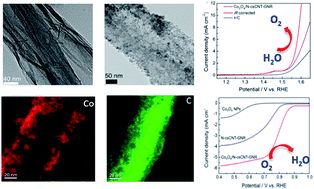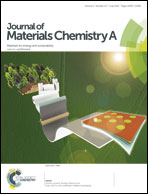Interconnected core–shell carbon nanotube–graphene nanoribbon scaffolds for anchoring cobalt oxides as bifunctional electrocatalysts for oxygen evolution and reduction†
Abstract
Bifunctional electrocatalysts for oxygen evolution reactions (OER) and oxygen reduction reactions (ORR) are crucial to the development of regenerative fuel cells or rechargeable metal–air batteries. However, the sluggish kinetics of OER and ORR often require the use of precious metal-based catalysts such as iridium, ruthenium, and platinum to lower the energy barriers of OER and ORR. Developing a highly efficient and stable bifunctional catalyst that is made of non-precious elements for ORR and OER still remains a significant challenge. Here, we show a novel catalyst architecture based on coupling non-precious Co3O4 nanocrystals onto nitrogen-doped, core–shell structured carbon nanotube–graphene nanoribbon (N-csCNT–GNR) scaffolds prepared by microwave-assisted, controlled upzipping of multiwall carbon nanotubes. The unzipped graphene nanoribbon shell enables a high surface area for loading of Co3O4 nanocrystals while the intact inner carbon nanotube core facilitates efficient transport of electrons. The as-prepared Co3O4/N-csCNT–GNR composite catalysts exhibit remarkably high activity towards both OER and ORR as a result of synergistic interactions between Co3O4 and the N-csCNT–GNR substrates.


 Please wait while we load your content...
Please wait while we load your content...